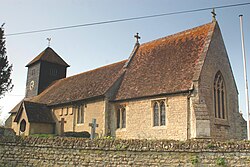Drayton St Leonard
| Drayton St Leonard | |
| Oxfordshire | |
|---|---|
 Parish church, Drayton St Leonard | |
| Location | |
| Grid reference: | SU588962 |
| Location: | 51°39’42"N, 1°9’4"W |
| Data | |
| Population: | 261 (2001) |
| Post town: | Wallingford |
| Postcode: | OX10 |
| Dialling code: | 01865 |
| Local Government | |
| Council: | South Oxfordshire |
| Parliamentary constituency: |
Henley |
| Website: | draytonstleonard.co.uk |
Drayton St Leonard is a village on the River Thame in Oxfordshire, in the meadows that stretch out from the River Thames, into which the Thame disgorges by Dorchester-on-Thames. Dorchester is just a mile and a half south-west of Drayton St Leonards.
The village is to be found eight miles south-east of Oxford.
Manor
The Domesday Book of 1086 does not list Drayton separately. At that time the land was part of the Bishop of Lincoln's estate of Dorchester. The village developed as a subsidiary of Dorchester. Upon the Dissolution of the Monasteries, Dorchester Abbey surrendered its lands to the Crown and Drayton remained with the Dorchester estate. By the 18th century the Earl of Abingdon was the principal landowner. In the 19th century the family still held the largest acreage, but Trinity College, Oxford had also become a significant landowner in the parish. Most of the land of the parish was farmed on an open field system until it was inclosed in 1861.[1]
Church and chapel
The Church of England parish church, St Leonard and St Catherine existed by 1146, when it was a chapel of the peculiar of Dorchester Abbey.[1] The Norman doorways in the north and south walls date from this time.[1] In the 13th century a transeptal chapel was added on the north side and new windows were inserted in the nave,[1] all in the Early Gothic style. The bell tower is timber, which is unusual for Oxfordshire,[2] (though there is a similar timber tower with a pyramid roof at Berrick Salome).[3] The oldest bell was originally cast in 1470, which could also be the date that the tower was built.
In the 16th century two of the nave windows were enlarged in the Perpendicular Gothic style.[4]
A stained glass portrayal of St Leonard in the lancet window in the north wall of the chancel originates from the middle of the 14th century, but most of the present pieces of its glass date from the 1859 restoration.[4] Ninian Comper and William Bucknall made the stained glass in the three-light east window of the chancel and two-light south-east window of the nave in 1894.[4] The latter is based on a painting by the 15th century Early Netherlandish painter Dirk Bouts in St Peter's Church, Leuven in Flanders.[4]
In 1859, the building was drastically restored under the direction of the Gothic Revival architect George Edmund Street. The external arch of the Norman south doorway was removed,[2] all tracery was removed from the chancel windows, and a Sanctus bell turret and sundial were removed from the eastern gable of the nave.[1] In 1884, the bell tower was strengthened, shingled and fitted with a clock.[1]
The Old Rectory, which was sold into private ownership after the Second World War, was designed by the architect John Billing and built in 1862[4] in the Victorian Gothic style for the new rector the Reverend Arthur Williams and his large family.
The first Methodist chapel in Drayton is said to have been built in 1814. It was replaced with a new building on a different site in 1879. The chapel was still used for worship in 1958.[1]
About the village
The oldest secular building in Drayton is a timber-framed barn. Its date is unknown but it is thought to be about 1400.[1] There are at least 15 houses and cottages dating from the 16th and 17th centuries,[1] several of which are thatched.
The village has one public house, the Catherine Wheel. Licensing records show that it was a public house by 1841.[1] For a time the village had a second public house, the Three Pigeons.[1] The building is now a private house but retains its pub name. The present structure dates from the 1930s, and replaced an earlier building that was destroyed by fire.
A National School was completed and opened next to the parish church in 1855.[1] In 1925 it was reorganised as a junior school, with older pupils being schooled in Dorchester.[1] The school was closed in 1947[1] and is now the village hall.
The village has a small private airstrip, suitable only for microlights and STOL aircraft.[5]
The Aston Martin Heritage Trust Museum is located in the village.
Pictures
| ("Wikimedia Commons" has material about Drayton St Leonard) |
References
- ↑ 1.00 1.01 1.02 1.03 1.04 1.05 1.06 1.07 1.08 1.09 1.10 1.11 1.12 1.13 Lobel, 1962, pages 71–81
- ↑ 2.0 2.1 Sherwood & Pevsner 1974, p. 587.
- ↑ L Tiller, St Helen's Church Berrick Salome, History page, Accessed 20 May 2013
- ↑ 4.0 4.1 4.2 4.3 4.4 Sherwood & Pevsner 1974, p. 588.
- ↑ "Drayton St Leonard Airfield". UKGA. http://ukga.com/airfield/drayton-st-leonard.
- Nikolaus Pevsner: The Buildings of England: Oxfordshire, 1974 Penguin Books ISBN 978-0-300-09639-2



